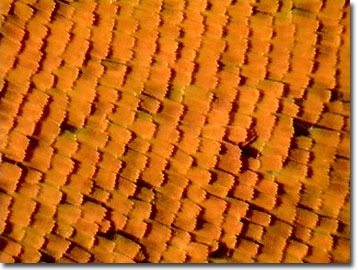Butterfly Wing Scale Digital Image Gallery
Autumn Leaf Butterfly
An autumn leaf butterfly would make a formidable foe in a game of hide-and-seek. When hanging upside down, completely still, with its wings folded and its undersides exposed, the species is almost impossible to distinguish from surrounding fall foliage. The cryptic wing undersides are purplish-brown, feature vein-like markings, and a pattern similar to the midrib of a leaf.

Scientifically named Doleschallia bisaltide, the autumn leaf butterfly does not always fade into the background. If its wings are spread for flight, the butterfly can be easily seen. The upper surfaces of the wings are bright orange and surrounded by a very broad margin of black that runs around the wingtips. Some subspecies of autumn leaf butterfly also exhibit white and yellow spots that are seasonally dependent. Both sexes of the autumn leaf butterfly are extremely similar in appearance, but females generally have slightly larger wings and stouter bodies.
During the larval stage, the autumn leaf caterpillar is as stunning as the adult butterfly. The very active larvae are boldly colored black and are covered with numerous cream spots, bright red spiracles, and blue markings. Black spines branch from their bodies and a pair of hairy horns extend from their heads. The nocturnal feeders often roam long distances to find new sources of food. Sometimes, however, caterpillars in the later stages of growth will eat smaller larvae of their own species, rather than continue the hunt for edible plants.
Indo-Australian in distribution, there are 22 recognized subspecies of autumn leaf butterflies, many of which are restricted to relatively small Pacific Islands. Some of the subspecies are already extinct and others are in danger. The Andaman leaf wing, a subspecies native to Andaman Island, has nearly disappeared and is classified as threatened by the International Union for the Conservation of Nature and Natural Resources, thus restricting it from international trade. Over-collection, ongoing destruction of Indo-Australian forests, and largely unrestricted use of pesticides are largely to blame for the plight of the Andaman leaf wing and other disappearing subspecies.
The species as a whole, however, does not appear to be in any immediate danger of extinction. Autumn leaf wing butterflies are reared in tropical butterfly farms and displayed alive at butterfly conservatories throughout the world. Moreover, the species has been reintroduced in locations where they had previously gone extinct. In Singapore, the native subspecies died out at the beginning of the twentieth century. The Australian subspecies, frequently called the Australian rustic, was recently introduced to the area and has since established self-reproducing populations.
Contributing Authors
Cynthia D. Kelly, Shannon H. Neaves, Laurence D. Zuckerman, and Michael W. Davidson - National High Magnetic Field Laboratory, 1800 East Paul Dirac Dr., The Florida State University, Tallahassee, Florida, 32310.
BACK TO THE BUTTERFLY WING SCALE IMAGE GALLERY
BACK TO THE DIGITAL IMAGE GALLERIES
Questions or comments? Send us an email.
© 1995-2025 by Michael W. Davidson and The Florida State University. All Rights Reserved. No images, graphics, software, scripts, or applets may be reproduced or used in any manner without permission from the copyright holders. Use of this website means you agree to all of the Legal Terms and Conditions set forth by the owners.
This website is maintained by our
Graphics & Web Programming Team
in collaboration with Optical Microscopy at the
National High Magnetic Field Laboratory.
Last Modification Friday, Nov 13, 2015 at 01:19 PM
Access Count Since January 21, 2003: 11396
Visit the website of our partner in introductory microscopy education:
|
|
